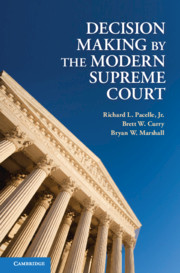Book contents
- Frontmatter
- Contents
- Acknowledgments
- 1 The Supreme Court
- 2 Heuristic Models of Judicial Decision Making
- 3 Building an Integrated Model of Decision Making
- 4 Decision Making on the Modern Supreme Court
- 5 Building a New Legacy
- 6 Sharing the Protection of Minorities
- 7 Avoiding Another Self-Inflicted Wound
- 8 Policing the Boundaries
- 9 Conclusion
- Measurement Appendix
- Cases Cited
- References
- Index
3 - Building an Integrated Model of Decision Making
Published online by Cambridge University Press: 05 June 2012
- Frontmatter
- Contents
- Acknowledgments
- 1 The Supreme Court
- 2 Heuristic Models of Judicial Decision Making
- 3 Building an Integrated Model of Decision Making
- 4 Decision Making on the Modern Supreme Court
- 5 Building a New Legacy
- 6 Sharing the Protection of Minorities
- 7 Avoiding Another Self-Inflicted Wound
- 8 Policing the Boundaries
- 9 Conclusion
- Measurement Appendix
- Cases Cited
- References
- Index
Summary
Each of the three models of decision making has something to contribute to the study of judicial behavior. We have made the argument that decision making on the modern Supreme Court (since Brown v. Board of Education) is more complex than either the attitudinal or the legal model standing alone and incorporates a wider range of factors than the strategic models. How, then, do we link the design of the framers, the practical realities of American politics, and these conceptual models of decision making? In this chapter, we build an integrative model that accounts for the major factors in the Court's environment. We discuss the variables that we see as critical to helping us understand decision making and present the measures we use to approximate those variables.
We analyze decision making within the context of neo-institutional research (March and Olsen 1984; Walker, Epstein, and Dixon 1988), which treats the Court as an actor whose behavior can be explained systematically. We begin with the premise that Gibson (1983, 9) advanced: Justices' decisions “are a function of what they prefer to do, tempered by what they think they ought to do, but constrained by what they perceive is feasible to do.” In translating this premise to institutional decision making, we argue that judicial behavior is a function of substantive preferences and structural considerations. Substantive preferences are at the heart of the attitudinal model.
- Type
- Chapter
- Information
- Decision Making by the Modern Supreme Court , pp. 51 - 62Publisher: Cambridge University PressPrint publication year: 2011



